
usb_2.0_english
.pdf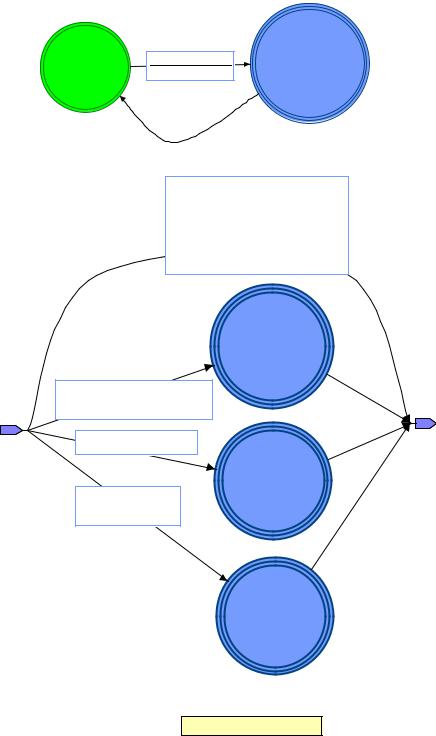
Universal Serial Bus Specification Revision 2.0
Global Actions |
Concurrent Statements |
Architecture Declarations |
Signals Status |
State Register Statements |
||
|
|
|
|
SIGNAL |
SCOPE |
DEFAULT |
Package List |
|
|
|
hsu1 |
OUT |
(BULK,NAK,0,0,ok,in_dir,TRUE,ALLDATA,FALSE,FA |
|
|
|
device |
INT |
’0’ |
|
|
|
|
|
|||
ieee |
std_logic_1164 |
|
token |
INT |
’0’ Process Declarations |
|
ieee |
numeric_std |
|
|
|
|
|
usb2statemachines behav_package |
|
|
|
|
||
No_packet |
Packet_ready(HSD2) |
Device_process_Trans |
|
Save(HSD2, token); |
|||
|
|||
|
|
Wait_for_packet(
HSD2, none);
Figure 8-22. Device Top Level State Machine
token.PID /= tokenOUT and token.PID /= tokenIN and token.PID /= tokenSETUP and token.PID /= ping and (token.PID = ping and
not device.HS)
Device_do_OUT
token.PID = tokenOUT or token.PID = tokenSETUP
token.PID = tokenIN
Device_do_IN
device.HS and token.PID = ping
Dev_HS_ping
Device_process_trans
Figure 8-23. Device_process_Trans State Machine
213
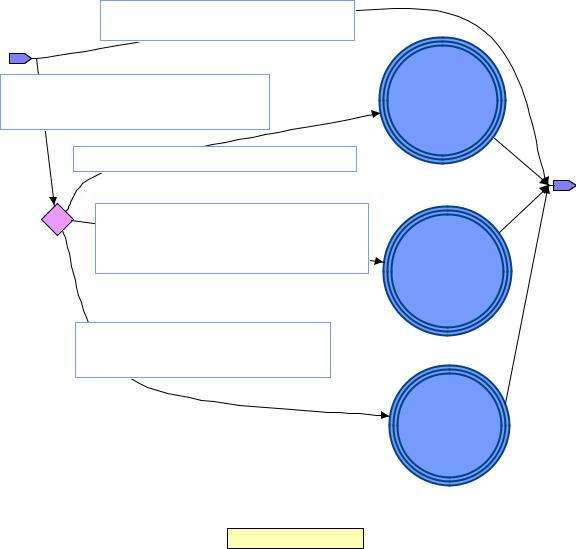
Universal Serial Bus Specification Revision 2.0
token.PID = tokenSETUP and device.ep(token.endpt).ep_type /= control
(token.PID = tokenSETUP and |
Dev_Do_IsochO |
device.ep(token.endpt).ep_type = control) or |
|
token.PID = tokenOUT |
|
device.ep(token.endpt).ep_type = isochronous |
|
&(not device.HS and (device.ep(token.endpt).ep_type = bulk or device.ep(token.endpt).ep_type = control)) or
device.ep(token.endpt).ep_type = interrupt
Dev_Do_BCINTO
device.HS and (device.ep(token.endpt).ep_type = bulk or device.ep(token.endpt).ep_type = control)
Dev_HS_BCO
Device_Do_OUT
Figure 8-24. Dev_do_OUT State Machine
214
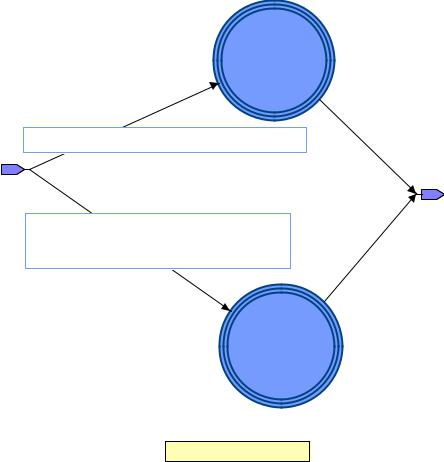
Universal Serial Bus Specification Revision 2.0
Dev_Do_IsochI
device.ep(token.endpt).ep_type = isochronous
device.ep(token.endpt).ep_type = bulk or device.ep(token.endpt).ep_type = control or device.ep(token.endpt).ep_type = interrupt
Dev_Do_BCINTI
Device_Do_IN
Figure 8-25. Dev_do_IN State Machine
215

Universal Serial Bus Specification Revision 2.0
HC_cmd.ep_type = isochronous
&
HC_cmd.ep_type = bulk or HC_cmd.ep_type = control or HC_cmd.ep_type = interrupt
HC_Do_IsochI
HC_Do_BCINTI
HC_cmd.direction = in_dir
HC_cmd.direction = out_dir |
HC_Do_IsochO |
|
HC_cmd.ep_type = isochronous
&
(not HC_cmd.HS and (HC_cmd.ep_type = bulk or HC_cmd.ep_type = control)) or HC_cmd.ep_type = interrupt
HC_Do_BCINTO
HC_cmd.HS and (HC_cmd.ep_type = bulk or HC_cmd.ep_type = control)
HC_HS_BCO
HC_Do_nonsplit
Figure 8-26. HC_Do_nonsplit State Machine
216
Universal Serial Bus Specification Revision 2.0
8.5.1 NAK Limiting via Ping Flow Control
Full-/low-speed devices can have bulk/control endpoints that take time to process their data and, therefore, respond to OUT transactions with a NAK handshake. This handshake response indicates that the endpoint did not accept the data because it did not have space for the data. The host controller is expected to retry the transaction at some future time when the endpoint has space available. Unfortunately, by the time the endpoint NAKs, most of the full-/low-speed bus time for the transaction had been used. This means that the full-/low-speed bus has poor utilization when there is a high frequency of NAK’d OUT transactions.
High-speed devices must support an improved NAK mechanism for Bulk OUT and Control endpoints and transactions. Control endpoints must support this protocol for an OUT transaction in the data and status stages. The control Setup stage must not support the PING protocol.
This mechanism allows the device to tell the host controller whether it has sufficient endpoint space for the next OUT transaction. If the device endpoint does not have space, the host controller can choose to delay a transaction attempt for this endpoint and instead try some other transaction. This can lead to improved bus utilization. The mechanism avoids using bus time to send data until the host controller knows that the endpoint has space for the data.
The host controller queries the high-speed device endpoint with a PING special token. The PING special token packet is a normal token packet as shown in Figure 8-5. The endpoint either responds to the PING with a NAK or an ACK handshake.
A NAK handshake indicates that the endpoint does not have space for a wMaxPacketSize data payload. The host controller will retry the PING at some future time to query the endpoint again. A device can respond to a PING with a NAK for long periods of time. A NAK response is not a reason for the host controller to retire a transfer request. If a device responds with a NAK in a (micro)frame, the host controller may choose to issue the next transaction in the next bInterval specified for the endpoint. However, the device must be prepared to receive PINGs as sequential transactions, e.g., one immediately after the other.
An ACK handshake indicates the endpoint has space for a wMaxPacketSize data payload. The host controller must generate an OUT transaction with a DATA phase as the next transaction to the endpoint. The host controller may generate other transactions to other devices or endpoints before the OUT/DATA transaction for this endpoint.
If the endpoint responds to the OUT/DATA transaction with an ACK handshake, this means the endpoint accepted the data successfully and has room for another wMaxPacketSize data payload. The host controller continues with OUT/DATA transactions (which are not required to be the next transactions on the bus) as long as it has transactions to generate.
If the endpoint instead responds to the OUT/DATA transaction with a NYET handshake, this means that the endpoint accepted the data but does not have room for another wMaxPacketSize data payload. The host controller must return to using a PING token until the endpoint indicates it has space.
217
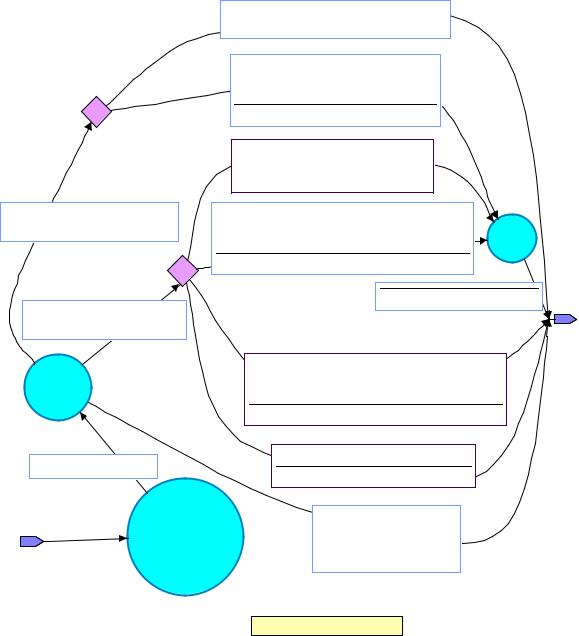
Universal Serial Bus Specification Revision 2.0
HSD2.x or |
not device.ep(token.endpt).space_avail |
|
(not HSD2.x) and |
|
HSD2.CRC16 = ok and |
|
device.ep(token.endpt).space_avail |
& |
Dev_accept_data; |
HSD2.x /= |
device.ep(token.endpt).toggle and |
HSD2.CRC16 = ok |
token.PID = tokenSETUP and |
HSD2.x = device.ep(token.endpt).toggle and |
|
HSD2.PID = datax |
HSD2.CRC16 = ok and |
Dopkt |
|
device.ep(token.endpt).space_avail |
|
|
|
|
|
Dev_accept_data; |
|
|
& |
|
|
Issue_packet(HSU1, ACK); |
|
token.PID = tokenOUT and |
|
|
HSD2.PID = datax |
|
|
|
HSD2.x = device.ep(token.endpt).toggle and |
|
Dchkpkt2 |
HSD2.CRC16 = ok and |
|
not device.ep(token.endpt).space_avail |
||
|
||
|
Issue_packet(HSU1, NAK); |
|
Packet_ready(HSD2) |
device.ep(token.endpt).ep_trouble |
|
Issue_packet(HSU1, STALL); |
||
|
||
|
(HSD2.PID = datax and |
|
Dev_wait_Odata |
HSD2.CRC16 = bad) or |
|
HSD2.PID /= datax or |
||
Wait_for_packet( |
||
HSD2.timeout |
||
HSD2, ITG); |
||
|
Dev_Do_BCINTO
Figure 8-27. Host High-speed Bulk OUT/Control Ping State Machine
8.5.1.1 NAK Responses to OUT/DATA During PING Protocol
The endpoint may also respond to the OUT/DATA transaction with a NAK handshake. This means that the endpoint did not accept the data and does not have space for a wMaxPacketSize data payload at this time. The host controller must return to using a PING token until the endpoint indicates it has space.
A NAK response is expected to be an unusual occurrence. A high-speed bulk/control endpoint must specify its maximum NAK rate in its endpoint descriptor. The endpoint is allowed to NAK at most one time each bInterval period. A NAK suggests that the endpoint responded to a previous OUT or PING with an inappropriate handshake, or that the endpoint transitioned into a state where it (temporarily) could not
218
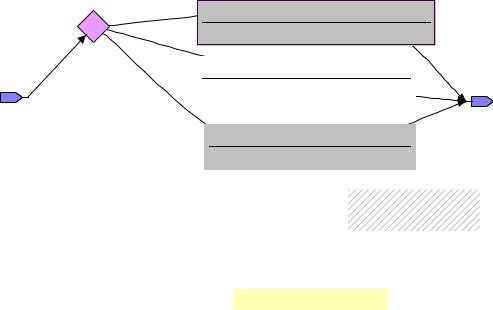
Universal Serial Bus Specification Revision 2.0
accept data. An endpoint can use a bInterval of zero to indicate that it never NAKs. An endpoint must always be able to accept a PING from the host, even if it never NAKs.
If a timeout occurs after the data phase, the host must return to using a PING token. Note that a transition back to the PING state does not affect the data toggle state of the transaction data phase.
Figure 8-27 shows the host controller state machine for the interactions and transitions between PING and OUT/DATA tokens and the allowed ACK, NAK, and NYET handshakes for the PING mechanism.
Figure 8-29 shows the device endpoint state machine for PING based on the buffer space the endpoint has available.
& |
not device.ep(token.endpt).space_avail |
|
Issue_packet(HSU1, NAK); |
||
|
||
|
device.ep(token.endpt).space_avail |
|
|
Issue_packet(HSU1, ACK); |
device.ep(token.endpt).ep_trouble
Issue_packet(HSU1, STALL);
Not allowed for control setup transaction
Dev_HS_ping
Figure 8-28. Dev_HS_ping State Machine
219
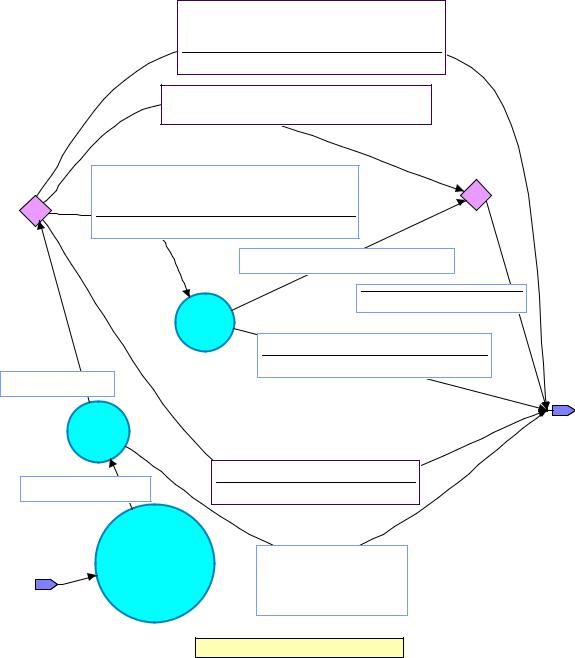
Universal Serial Bus Specification Revision 2.0
HSD2.x = device.ep(token.endpt).toggle and |
HSD2.CRC16 = ok and |
not device.ep(token.endpt).space_avail |
Issue_packet(HSU1, NAK); |
HSD2.x /= device.ep(token.endpt).toggle and
HSD2.CRC16 = ok
HSD2.x = device.ep(token.endpt).toggle and |
|
HSD2.CRC16 = ok and |
& |
&device.ep(token.endpt).space_avail
Dev_accept_data;
device.ep(token.endpt).space_avail
Issue_packet(HSU1, ACK);
Dspace
HSD2.PID = datax
not device.ep(token.endpt).space_avail
Issue_packet(HSU1, NYET);
Dchkpkt |
|
|
device.ep(token.endpt).ep_trouble |
Packet_ready(HSD2) |
Issue_packet(HSU1, STALL); |
Dev_wait_Odata1
Wait_for_packet(
HSD2, ITG);
(HSD2.PID = datax and HSD2.CRC16 = bad) or HSD2.PID /= datax or HSD2.timeout
Dev_HS_BCO
Figure 8-29. Device High-speed Bulk OUT /Control State Machine
Full-/low-speed devices/endpoints must not support the PING protocol. Host controllers must not support the PING protocol for full-/low-speed devices.
Note: The PING protocol is also not included as part of the split-transaction protocol definition. Some split-transactions have equivalent flow control without using PING. Other split-transactions will not benefit from PING as defined. In any case, split-transactions that can return a NAK handshake have small data payloads which should have minor high-speed bus impact. Hubs must support PING on their control endpoint, but PING is not defined for the split-transactions that are used to communicate with full-/low- speed devices supported by a hub.
220
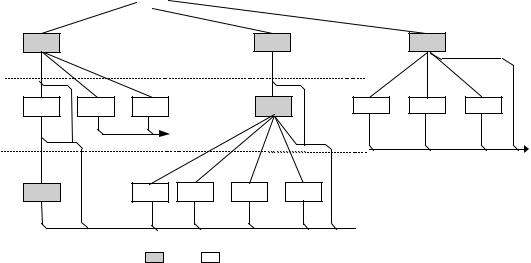
Universal Serial Bus Specification Revision 2.0
8.5.2 Bulk Transactions
Bulk transaction types are characterized by the ability to guarantee error-free delivery of data between the host and a function by means of error detection and retry. Bulk transactions use a three-phase transaction consisting of token, data, and handshake packets as shown in Figure 8-30. Under certain flow control and halt conditions, the data phase may be replaced with a handshake resulting in a two-phase transaction in which no data is transmitted. The PING and NYET packets must only be used with devices operating at high-speed.
Idle
High-speed OUT only
oken |
|
|
OUT |
|
|
PING |
|
|
IN |
|
|
|
|
|
|
||
|
|
|
DATA0/ |
Error |
|
|
Error |
|
DATA0/ |
NAK |
STALL |
ACK |
NAK |
STALL |
|||
|
||||||||
DATA1 |
|
|
DATA1 |
|
|
|
|
|
ata |
Error |
|
|
|
|
|
|
|
|
|
Idle |
|
|
|
|
||
|
|
|
|
|
|
|
||
|
|
|
|
|
|
|
Idle |
andshake |
|
High-speed only |
|
|
|
|
|
|
|
|
|
|
|
ACK |
Data |
NYET |
ACK |
NAK |
STALL |
Data |
|
Error |
|
|
|
|
Error |
 Idle
Idle
Host Function
Figure 8-30. Bulk Transaction Format
When the host is ready to receive bulk data, it issues an IN token. The function endpoint responds by returning either a data packet or, should it be unable to return data, a NAK or STALL handshake. NAK indicates that the function is temporarily unable to return data, while STALL indicates that the endpoint is permanently halted and requires USB System Software intervention. If the host receives a valid data packet, it responds with an ACK handshake. If the host detects an error while receiving data, it returns no handshake packet to the function.
When the host is ready to transmit bulk data, it first issues an OUT token packet followed by a data packet (or PING special token packet, see Section 8.5.1). If the data is received without error by the function, it will return one of three (or four including NYET, for a device operating at high-speed) handshakes:
•ACK indicates that the data packet was received without errors and informs the host that it may send the next packet in the sequence.
•NAK indicates that the data was received without error but that the host should resend the data because the function was in a temporary condition preventing it from accepting the data (e.g., buffer full).
•If the endpoint was halted, STALL is returned to indicate that the host should not retry the transmission because there is an error condition on the function.
If the data packet was received with a CRC or bit stuff error, no handshake is returned.
Figure 8-31 and Figure 8-32 show the host and device state machines respectively for bulk, control, and interrupt OUT full/low-speed transactions. Figure 8-27, Figure 8-28, and Figure 8-29 show the state machines for high-speed transactions. Figure 8-33 and Figure 8-34 show the host and device state machines respectively for bulk, control, and interrupt IN transactions.
221
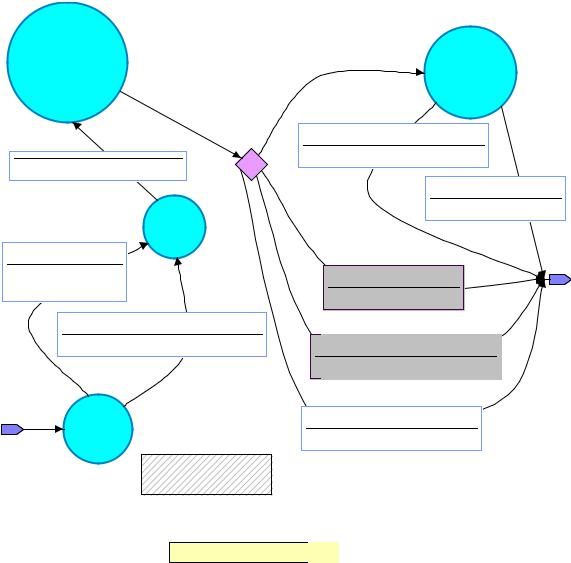
Universal Serial Bus Specification Revision 2.0
|
|
(HSU2.PID /= STALL and |
|
Wait_resp |
|
HSU2.PID /= NAK and |
|
|
HSU2.PID /= ACK) or |
||
Wait_for_packet( |
|
HSU2.timeout |
|
HSU2, ITG); |
|
|
|
|
|
|
|
|
|
|
|
|
Packet_ready(HSU2) |
|
|
|
|
|
|
BCI_error
IncError;
ErrorCount < 3
RespondHC(Do_same_cmd);
Issue_packet(HSD1, datax); |
& |
|
ErrorCount >= 3
RespondHC(Do_halt);
|
Do_data |
|
not HC_cmd.setup |
|
|
Issue_packet( |
HSU2.PID = STALL |
|
HSD1, tokenOUT); |
||
RespondHC(Do_halt); |
||
|
HC_cmd.setup |
|
Issue_packet(HSD1, tokensetup); |
HSU2.PID = NAK |
RespondHC(Do_same_cmd);
HSU2.PID = ACK
Do_token
RespondHC(Do_next_cmd);
Not allowed for control setup transaction
HC_Do_BCINTO
Figure 8-31. Bulk/Control/Interrupt OUT Transaction Host State Machine
222
